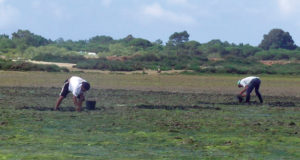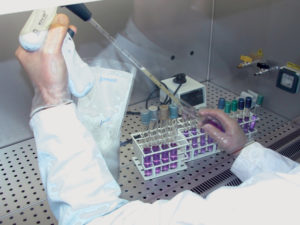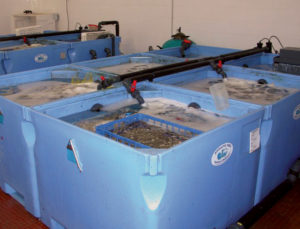IPIMAR assessing effects of water, rainfall on variations of E. coli

The commercial production of clams, oysters, and cockles is a century-old activity in the Algarve of southern Portugal that accounts for 90 percent of the total bivalve mollusk production in the country. Under favorable conditions, annual production can reach 22,000 metric tons (MT) and represents an important source of sustenance and income for 3,000 people.
Most of the production takes place in intertidal bottom culture beds located in the Ria de Alvor and Ria Formosa lagoon systems, and Arade Estuary. Over the last decades, human population growth and development in adjacent watersheds have posed significant threats to these uniquely productive and fragile coastal environments.
The proliferation of pollution from traditional agriculture, industrial scale animal production, and tourism-related activities has led to the deterioration of water quality and microbiological contamination of bivalve mollusks in some lagoon systems. Governmental authorities declared water quality a key environmental indicator of sustainable development in the Algarve.
Monitoring advances
As the competent authority for public health controls on the commercial production of bivalve mollusks within Portugal, Instituto de Investigação das Pescas e do Mar (IPIMAR) is improving the monitoring strategy used to assess the risk of contamination of mollusk-harvesting areas by pathogenic microorganisms and assuring that depuration and dispatch centers are operating according to conditions set out in legislation.
Fecal coliform bacteria were used as indicators of fecal contamination in bivalve mollusk areas in the Algarve for a long time. In 2005, this indicator was substituted by Escherichia coli, a bacterium more specifically associated with the intestines of warm-blooded animals and birds.
The recovery of E. coli is performed in microbiological testing of bivalve samples in a five-tube, three-dilution “most probable number” method with modified glutamate broth. Detection is confirmed of β-glucuronidase on 5-bromo-4-chloro-3-indolyl-β-D glucuronide agar.
Meteorologic, hydrographic effects
As stated by European Union legislation, the competent mollusk-monitoring authority IPIMAR must examine the quantities of pollutants released during different periods of the year according to seasonal variations in rainfall and both human and animal populations in the catchment area, and determine the characteristics of the circulation of pollutants in harvesting areas.
Currently, IPIMAR is assessing the effects of various parameters of water and rainfall (temperature, salinity, dissolved oxygen, pH) on the variations of E. coli in bivalves. Preliminary results indicate that rainfall events have a major contribution in increasing the amount of fecal contamination in bivalve mollusks.
Contamination sources

IPIMAR must also make an inventory of the human and animal sources of pollution that are likely to be sources of contamination for the production area. IPIMAR is acquiring information on sewage treatment plants (discharge volume, type of treatment, plant performance), combined sewer overflows, land use (pasture, urban areas, roads, animal feed lots), wildlife, and harbors and marinas.
A primary assessment of Ria de Alvor Lagoon evidenced the role of animal feed lots in fecal contamination that can enter lagoon systems and contaminate bivalve mollusks during periods of intense runoff.
Integrated data system
The information from the microbiological monitoring program is being integrated into a geographic information system to characterize the location of harvesting areas, define sampling points and sampling frequency, and classify mollusk-harvesting areas according to microbiological criteria.
The system was useful in redefining harvesting areas in the lagoon systems. It is now prepared for the classification of 27 bivalve mollusk-harvesting areas in the Algarve, which correspond to nearly 1,600 bottom production plots of the Ruditapes decussatus clam, and contains information on monthly levels of fecal coliforms and E. coli monitored in the species between 1990 and 2005.
Inspections, quality assurance

IPIMAR participates in ongoing technical inspections of depuration and dispatch centers in order to verify the efficacy of mollusk depuration systems. In addition, technical inspections are performed annually at private laboratories that undertake microbiological testing of samples of bivalve mollusks from the depuration centers.
As an essential element of good laboratory practice assurance, the IPIMAR Laboratory of Microbiology participates in the shellfish program organized by the Public Health Laboratory Service and the Centre for Environment, Fisheries, and Aquaculture of the United Kingdom. Under the program, the IPIMAR lab is required to examine samples of simulated bivalve mollusks for the presence of Salmonella and E. coli and return results to the organizers.
All these tasks were developed in the scope of the MARIS project (MARIS is a project for the improvement of the sanitary quality of bivalve molluscs, and for public awareness for the need of the sanitary certification of these animals). The main purpose of this project is to manage public health risks arising from the consumption of bivalve mollusks.
(Editor’s Note: This article was originally published in the July/August 2006 print edition of the Global Aquaculture Advocate.)
Now that you've finished reading the article ...
… we hope you’ll consider supporting our mission to document the evolution of the global aquaculture industry and share our vast network of contributors’ expansive knowledge every week.
By becoming a Global Seafood Alliance member, you’re ensuring that all of the pre-competitive work we do through member benefits, resources and events can continue. Individual membership costs just $50 a year. GSA individual and corporate members receive complimentary access to a series of GOAL virtual events beginning in April. Join now.
Not a GSA member? Join us.
Authors
-
Carlos J.A. Campos
Instituto de Investigação das Pescas e do Mar
Centro Regional de Investigação Pesqueira do Sul
Av. 5 de Outubro
8700-305 Olhão, Portugal -
Rui A. Cachola
Instituto de Investigação das Pescas e do Mar
Centro Regional de Investigação Pesqueira do Sul
Av. 5 de Outubro
8700-305 Olhão, Portugal
Tagged With
Related Posts

Health & Welfare
Algae shows promise as alternative DHA source in rainbow trout diets
A growth trial in Canada evaluated the use of algae biomass to increase the concentration of long-chain polyunsaturated fatty acids in the tissues of rainbow trout.

Aquafeeds
Amino acid requirements in developing marine fish
Most marine fish have pelagic eggs with large pools of free amino acids of fairly constant proportion regardless of species. The amino acids provide energy for metabolism and are an important nutritional asset for growing embryos.

Intelligence
Brazilian aquaculture: Constraints and challenges (Part 2)
Brazil will have to deal with an adverse economic and political environment in the next few years. One should expect high value fish products like shrimp, tilapia, Chilean salmon and cod being replaced by more affordable seafood and alternative meats, as consumers keep losing purchasing power due to inflation, unemployment and monetary devaluation.

Intelligence
Cup size matters, but for oysters, branding matters more
To name an oyster is to give birth to a brand, essential to stand out in today’s raw bar scene. The briny bite-sized morsels are arguably seafood’s sexiest offerings, but a memorable moniker (and a quality product) is what keeps them on the menu.


